|
Advice article filter
|
The basic feeding requirements for your horseDifferent building blocks in feed contribute to your horse’s health. Both roughage as well as concentrated feed contains nutrients that supply energy and ensure recovery and growth of the horse’s body. But what exactly are the basic feeding requirements of your horse, and how does it take in these nutrients? Roughage consists of among other things carbohydrates, water, fibres, sugars, proteins, vitamins and minerals. In addition, concentrated feed is supplemented with starch and vegetable fats. All these nutrients have different functions for your horse. The basic feed requirements of your horseWhat a horse needs in addition to its roughage in respect of vitamins, minerals and trace elements, concentrate feed or supplements, depends on a number of aspects. The need for feed is determined by, among other things, what the horse does (type of exercise), its weight and build, and the outside temperature. To cover the need for feed, you need supply which comes from roughage and possibly additional products. As the most important part of nutrients is provided by roughage, the quality of this roughage determines to a large extent precisely what the intake of the horse is in respect of nutritional components. In addition, it is important what type of horse you have, how much you exercise your horse, and if it is a mare, whether she is lactating. All these factors together determine what supplements your horse may require. CarbohydratesCarbohydrates can be distinguished in complex and water-soluble carbohydrates. Soluble carbohydrates are sugars and starch and are broken down by enzymes in the stomach and small intestine. This process provides the horse with a lot of energy. It is important that the breakdown of soluble carbohydrates takes place properly, otherwise sugars and starch will pass on to the large colon where they can disrupt the micro flora. This will lead to an increased risk of gas colic and laminitis. As the grass grows older, it contains more fibres. The carbohydrates of these fibres are too complex to digest. Only in the large colon of the horse can these fibres be broken down into useful nutrients, which is done by bacteria. The horse’s digestion cannot function properly without sufficient fibres. If the large colon is insufficiently active, the risk of all kinds of digestion problems and sicknesses occurs, such as colic or laminitis. ProteinsIn the entire digestive tract the proteins that a horse extracts from feed are broken down into amino acids, however, these are only absorbed properly in the small intestine. These amino acids are essential building blocks for the proper functioning of the body. The horse uses them for example for growth, muscle development, coat, hooves and skin, blood corpuscles and replacement of the body protein. Some of the amino acids can also be produced by the horse itself, so the feed does not need to contain those. Protein content in horse feedProtein is an important building block for the body and it plays an important role in tissue repair and build-up of muscles. The moment of cutting time and the extent of fertilization affect the protein content to a considerable extent. Protein is mainly found in the leaves of the grass plant, the stem provides hardly any protein. If the grass is cut at a late stage (e.g. mid-June or the beginning of July), the hay will contain a large amount of stems and relatively little leaf. The result is a considerable decrease of energy value and protein content of the hay. A low energy value is ideal for normal horses, but less for horses that compete at top sport level or horses that are used for breeding. These horses have a considerable need for protein and run the risk of deficiencies. When we talk about horse feed, we use the terms Crude Protein (CP) and Digestible Crude Protein horse (DCPh). Crude protein is the total quantity of protein in the roughage; Digestible Crude Protein indicates how much protein the horse can actually digest. A calculation example: if you give your horse 10 kg hay per day and the amount of Digestible Crude Protein (DCPh) is 60 grams per kilo hay (the amount that a normal competition horse should take in), then your horse really does take in 600 grams of protein per day. How much protein does your horse need?The total protein content in roughage for ‘normal’ horses that are used as leisure horses or exercised lightly, should be become minimally 60 grams per kilo dry matter, but for broodmares and horses that have to work hard, it should preferably be to give them more than 100 grams per kilo dry matter. Most roughage contains too little protein for high level competition horses and broodmares, in which case this needs to be topped up by means of concentrate feed. Other horse owners only need to worry about an addition of vitamins, minerals and trace elements. The balancer Pavo Vital or Pavo SummerFit biscuits serve this purpose well. How much energy does a horse need?The energy requirements of competition horses lie, depending on the intensity of the exercise, somewhere between 7.1 and 11.0 EVh (Energy Value horse) per day. When we look at the average hay/silage which is fed to horses in the Netherlands, it contains 0.47 EVh per kilo (0.61 EVh per kilo dry matter). In order to cover the energy requirements of 7.1 EVh per day, you would need to feed 15 kg of hay per day. And to cover the energy requirements of a horse competing at high level that requires 11 EVh per day, you would need to give 23 kg of the average hay produced in the Netherlands. That is simply impossible, which is why competition horses generally need concentrated feed, such as Pavo TopSport, Pavo SportsFit or Pavo Ease&Excel, in order to cover the higher energy requirements. Sugar content in horse feedThe largest amount of the daily sugar intake of horses is provided by grass or hay. When the sugar content is too high, this can result in overweight, laminitis and insulin resistance. Rightly so, there is a lot of attention to sugar in the diet of problem horses. Do not only pay attention to contents (and quantities) in the concentrate feed, but indeed also have a good look at the contents of grass, silage and hay. Because compared to concentrates, per day, horses eat many more kilos of roughage. The sugar contents of hay, grass and silage differ. Usually hay and silage contain 100 grams of sugar per kilo dry matter. In other words, 10 percent of the dry matter in hay or silage is sugar. If a horse eats 10 kg of dry matter hay (which equals approximately 11.5 kg of hay) it takes in one kilo of sugar. Put the horse out to grass around the clock and it will take in at least 2 kg of sugar per day. The sugar content of hay and silage can vary a lot. If the grass was cut in the morning, the sugar content is considerably lower than when it is cut at the end of the afternoon. Optimally, the sugar content in roughage should be between 40 and 100 grams per kilo dry matter. If the sugar content exceeds 140 grams, it really is too high. Vitamins, minerals and trace elementsOur roughage monitor shows that the roughage in the Netherlands almost always has a deficiency of the trace elements zinc, copper and selenium. Minerals are involved in important bodily functions. Calcium, phosphorus and magnesium in particular are important. A horse needs quite a lot of these, meaning, the required amounts are measured in ‘tablespoons’ per day. Essential for the quality of roughage is the ratio between calcium and phosphorus which ensures a strong bone quality. Normally, that ratio should be between 1.5 - 2.5 to 1. This means that the calcium content should roughly be twice as high as the phosphorus content. Roughage for young horses should ideally have a ratio of 1.5 - 2.0 to 1. The most important trace elements for horses are copper, zinc, manganese and selenium. These elements are called trace elements because horses need them only in very small quantities (milligrams) per day, but they really do need them. Copper is important for the bone development and to form haemoglobin and zinc is needed for protein synthesis and the metabolism. Selenium is an antioxidant and thus important for the immune system and the muscles. Selenium is important, but note: it is poisonous when overdosed. An iron deficiency is hardly ever a problem for horses, in roughage samples we always see huge amounts of iron (perhaps even too much). 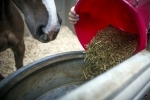
Pavo CerevitThe complete basic muesli for every horse and pony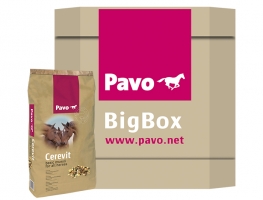 Pavo Ease&ExcelInnovative blend to support gastric function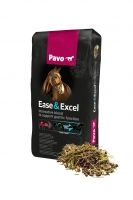 Pavo SportsFitThe sport muesli for all disciplines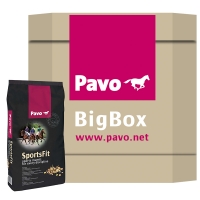 Pavo SummerFitThe daily vitamin and mineral supplement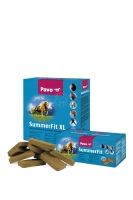 Pavo TopSportThe muesli topping for sport horses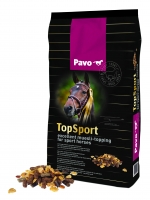 Pavo VitalDaily vitamin and mineral balancer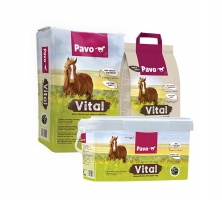 |

